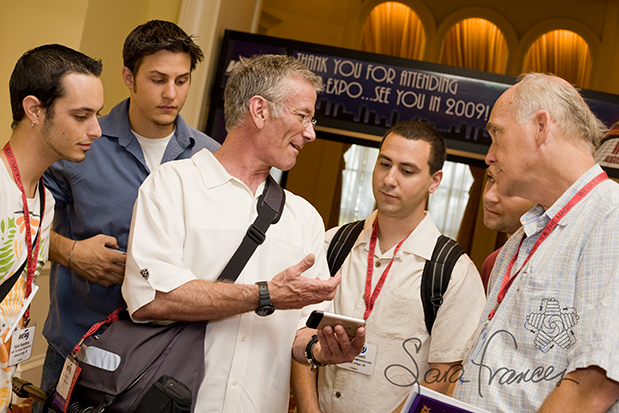
Visually true to life, the 48-55MM lens is so right for so many situations, particularly if you’re a documentarian like myself. In short, normal angle lenses give you the same perspective, proportion and relative size of objects as the human eye sees. I can’t imagine being without one in my kit; it’s the old stand by.
In this PR pic for WEVA, Karl is explaining his technique to video convention goers. Notice how all the heads look real and equal in size, a characteristic benefit of the normal lens. I bent down and looked up to include the signage that gives a sense of time and place.
Here?s what normal angle lenses are good for:
- very real appearance of capture
- natural perspective; backgrounds don’t look too near or too far away
- basic crop without including too much extraneous material in the frame
- great for small groups, 3-5 persons 3/4 closeup, or formal wedding groups
- fast ‘/stop great in low light, easy to focus in all situations
- easy to use compared to moderate telephoto in fast situations or following a moving subject
- inexpensive
And the cons:
- not tight enough for couples pictures, for instance across a round banquet table
- way too far away for speakers or workshop presenters and audience reaction shots
- simplicity of size and use can make you lazy in choosing camera viewpoint
Most normal angle lenses are inexpensive, light weight and very easy to achieve quick, accurate focus, primarily because they generally have a low ‘/stop – ‘/1.2-1.8. Fast lenses give you a big leg up in demanding situations like low light and moving subjects. You may not use the maximum aperture for exposure, but it?s your silent friend, helping you to grab focus much quicker before your subject can move out of range. Speed of focus is a function of the widest aperture of the lens, the ambient light available, which focal point is selected and the physical weight of the glass. This is also a great reason not to purchase the less expensive progressive zoom lenses, where the ‘/stop increases the longer you zoom the MM.
When doing reconstructive Photoshop surgery on disappointing images that clients bring to me (done by other studios), I can testify how often the amateur or less experienced photographer loses shot after panicked shot to blur, incorrect white balance and bad exposure. This is where practiced skills earn you money and sets you apart from the typical event photographer. Often the basic normal angle lens will help you avoid these technical problems. Spontaneous moments and expressions sell, and if they?re in focus, well exposed and tightly composed, they?re more precious than gold. Lucky you to cash in!
